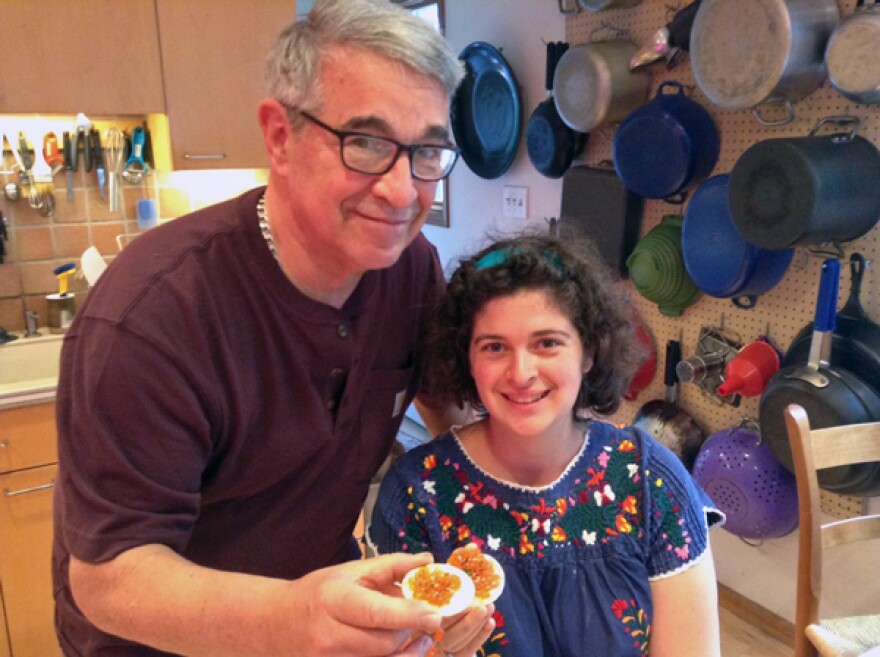Today we’re making caviar Alaska style; made from salmon roe.
Natasha Price writes the food and crafts blog Alaska Knit Nat, and she recently posted a how-to guide for making salmon caviar. It’s a family recipe, and one that Natasha didn’t really like growing up.
“I just always thought it tasted gross, like fish,” Natasha said. “And I didn’t like the sensation of the eggs popping in my mouth.”
But about four years ago she tried it again.
“I had a bite with a cracker and a little sip of white wine and it was pretty much the best thing ever,” Natasha said, laughing.
The recipe was created by Natasha’s dad, Oliver. He can’t remember how long ago he came up with it, but he says it was before the internet.
“So we just had to figure it out,” Oliver said. “We had no idea how to make it, and it turns out it’s ridiculously simple as you’ll see.”
It really is easy to make, but there are a few things you need to be sure to do beforehand. You need to get your roe on ice immediately, and when you get it home you need to turn it into caviar within a few days. Natasha says no more than 48 hours.
“It’s a last minute thing,” she said. “So if you know someone who’s going fishing, you say ‘the last day you’re going fishing keep them on ice.’”
To make the caviar, you’ll only need a single tool; something that can separate the roe from the skein, that clear membrane that holds the eggs together.
Natasha: “We have this mesh grate over a bowl, and what is this a quarter inch?” Oliver: “It’s actually five sixteenths I just measure it, but a quarter inch would work fine.” Natasha: “Or a tennis racket.”
The skein is placed on top of the mesh grate, and the eggs are pushed through by hand.
Natasha: “It looks like it’s going to be easy, but it actually takes a little bit of effort. You’ve got to kind of scrape it along the grate, and you can seem them fall into the bowl.” Dave: “And you’re pushing them pretty hard, harder than I would expect with something as delicate as roe.” Natasha: “You have to be a little aggressive. You put your finger on the membrane and then scrape away the eggs.”
Next, Oliver creates a salt bath for the eggs.
“It’s a super saturated solution, meaning you put enough salt in so that it stops dissolving and no more will go into solution,” he said. “That’s the way you know it’s a saturated solution.”
Oliver then stirs the roe into the salt water. These are sockeye eggs, which take about 12 minutes to turn into caviar. Oliver says with King eggs you’d wait 25 minutes.
“We’re doing a test sample to see if they’ve been brined long enough,” Natasha said as the timer goes off. “And this depends on your taste and how salty you want them, but we’re going to do a little tester…pretty good, maybe a little longer.”
“I think we should go a little longer,” Oliver said.
Oliver says the great thing about making salmon caviar is you can get away with mistakes. If you under salt the eggs, simply leave them in the water longer.
“And if you over salt them you can just put them in fresh water and the osmosis will go the other way, and they’ll get desalinated,” Oliver said. “So if you make a mistake, as long as the eggs are fresh, they’re membranes are still capable of osmosis one way or the other.”
After about two more minutes the pair gives the eggs another taste.
Oliver: “I’d give it two more minutes.” Natasha: “Really?” Oliver: “OK, if you think it’s done we could do it now.” Natasha: “I think it’s done, I’m going to eat the rest of these (devious chuckle).”
Natasha puts the roe into a strainer and washes it with cold water to remove the excess salt.
“They look like little orange jewels,” she said. “They’re beautiful.”
They do look beautiful, but it’s time for the real test – the taste.
“It has an interesting sweetness to it, followed by a little bit of ocean flavor, finished with some salty flavor,” Natasha said. “And the texture is interesting. They’re soft, and they pop in your mouth when you’re eating them.”
“’Popability’ is an important trait,” Oliver said. “If it doesn’t pop, they’re not that fresh.”
Of course, Natasha’s drink of choice with caviar is white wine. Oliver prefers red, but he says when you’re eating fresh, salty poppy caviar it doesn’t matter what you’re drinking, you’re living the life.
For more information, visit CaviarMania .





